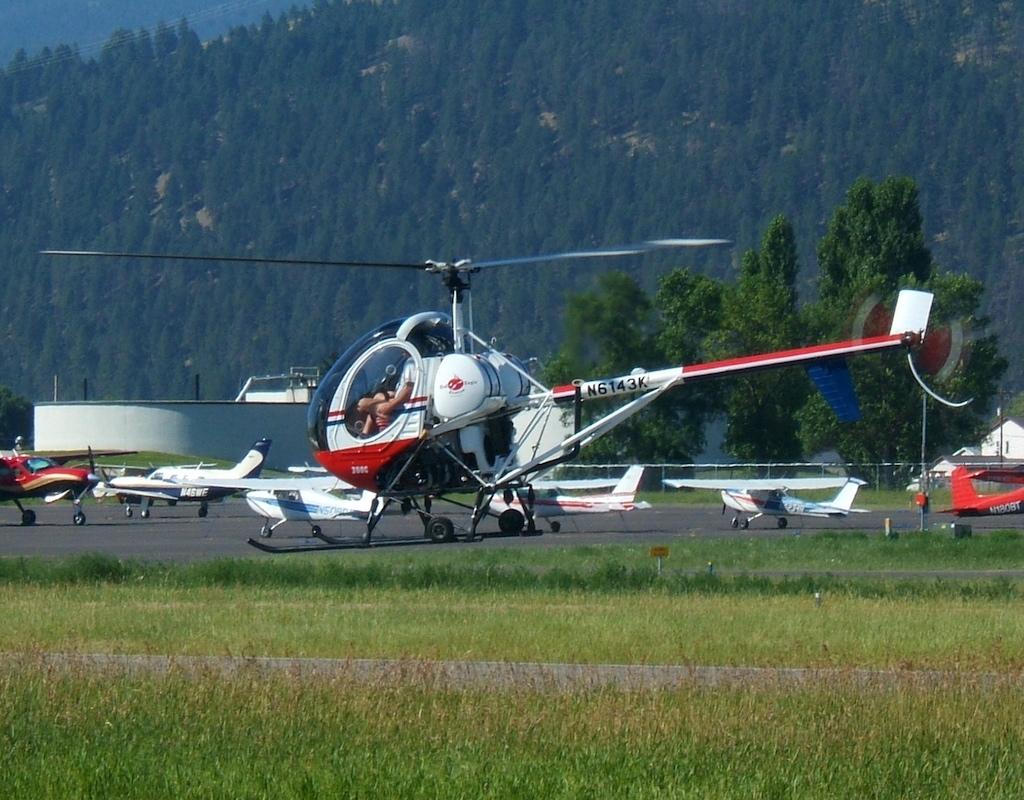
Autorotation practice in a helicopter involves unusually steep angles and rates of descent.
The launch of a glider is frequently done in the U.S. with a tow plane. The launching process is aided with the help of a couple of willing volunteers who will pull the glider into position on the runway, then grab the tow rope and attach it to the nose of the glider.
Meanwhile, the glider pilot is running through the final checklist before takeoff. Upon verification from the glider pilot the ground crew will signal to the tow plane pilot to slowly take up the slack in the tow rope, then with a waggle of the rudder by the glider pilot the tow plane will begin to accelerate.
The takeoff roll and climb-out of the tow plane with a glider in tow will be longer than most other aircraft. The process requires an increment of time during which the runway is occupied.
Don’t automatically assume that the tow plane and glider’s climb-out from the end of the runway means that they will continue climbing out. One of the necessary training maneuvers in glider training is the premature termination of the tow. It mimics the situation in which the tow rope breaks without notice. If this occurs early in the takeoff process the glider will land straight ahead.
Depending on the runway and nearby fields, it is possible for a glider experiencing a rope break at 200 ft. to make a rapid 180-deg. turn to return to the runway. While actual tow-rope breaks are infrequent, this maneuver is an important component of glider training. Therefore, if you are taking off or landing behind a glider that has just launched, be on guard for the possibility of the glider making a rapid return to the runway, albeit against the traffic flow.
Rotorcraft, both helicopters and gyroplanes, fly slower and approach at steeper angles than airplanes. One of the distinctive maneuvers in helicopter training is the practice for a simulated power-off landing called an autorotation. Training for private and commercial helicopter pilot certificates requires proficiency from both a straight-in and 180-deg. turning condition. This maneuver involves exceptionally steep angles of approach and high rates of descent (1,500-to-2,000 fpm).
Fixed-wing pilots may not be aware of the intense workload in the cockpit of a helicopter practicing this maneuver. Until you have attempted an autorotation it is hard to appreciate the sudden onset of the rapid descent rate. Slight changes in the helicopter’s cyclic or collective can make excessive changes in the main rotor speed. This maneuver is especially challenging in helicopters with low inertia rotors, and requires intense concentration to make the finite control adjustments to keep the main rotor within the narrow speed limits.
Often a training helicopter will terminate the autorotation maneuver a few feet above the ground to a “power recovery.” The pilot-trainee will stabilize the helicopter in this hover and check the gauges to make certain everything is in the green before resuming a takeoff.
Gyroplanes must “pre-spin” the rotor blades to a minimum RPM speed before beginning the takeoff roll. It takes a definitive amount of time for the rather small pre-rotator to spin the long rotor blades from zero RPM to approximately 200-225 RPM (depending on the gyroplane’s specific requirements). The process has to be done slowly because attempting to apply too much torque to the pre-rotator will stall out the engine.
Thus, the gyroplane is sitting in the takeoff position on the runway for roughly 1 1/2 minutes for the rotor blades to spin up to the necessary speed. A courtesy call by a gyroplane taxiing into position should alert other aircraft in the pattern of the need for this necessary time interval.
IFR Flight Plans
An aircraft on an IFR flight plan originating at an uncontrolled airport has the extra challenge of coordinating with an ATC facility for its IFR clearance. Some locations have a remote communications outlet. Others have a direct frequency to a nearby approach control. In other places it may be necessary to use a telephone to speak with the ATC facility.
This often results in the infamous “clearance void” time. Yes, often these clearance void times seem tight, and clearly ATC is assuming that you are holding short of the runway ready for takeoff. Non-IFR pilots are not cognizant of the timing and workload issue for an IFR aircraft holding short of the active runway anxiously hoping to depart immediately to avoid not making the clearance void time. This doesn’t mean that you have priority over all other aircraft in the pattern.
The intermix of aircraft at an uncontrolled airport also creates the risk of wake, rotor, propeller or jet wash effects on light aircraft. Pilots of jets and turboprops should utilize the minimum possible power for taxi movements on the ramp and taxiways. It is recommended that helicopters use the air taxi maneuver for ground movements to proceed at an optimal airspeed and minimize downwash effects while avoiding flight over other aircraft, vehicles and people.
Pilots of light aircraft should be aware that the wake vortices from a helicopter can be disproportionately stronger and have resulted in wake turbulence accidents.
This mix of traffic safely coexists without a control tower when all pilots are following the recommended operations and communications procedures. This mix also requires courtesy among ourselves to smoothly integrate all of our varying needs and limitations.
Lastly, professional pilots need to stay up-to-date on the important procedures that keep us all safe.
To read Proper Procedures At Uncontrolled Airports, Part 1, click here.
To read Proper Procedures At Uncontrolled Airports, Part 2, click here.





